Meet 11 female painters working in a wide range of styles & subjects
This story was featured in the October 2017 issue of Southwest Art magazine. Get the Southwest Art October 2017 print issue or digital download now–then subscribe to Southwest Art and never miss another story.
Jean Lightman
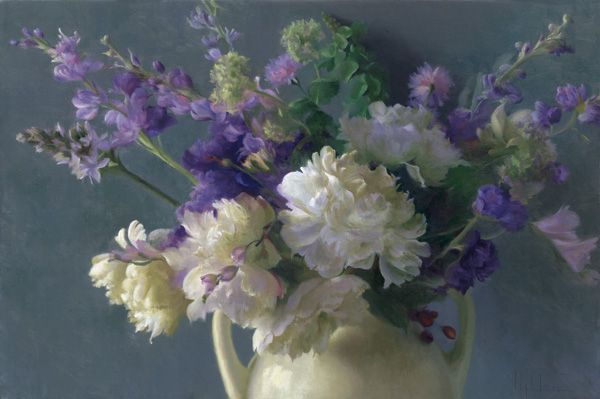
Jean Lightman, Qi, oil, 19 x 29.
When Jean Lightman assembles the tableaux for her floral paintings, she arranges the blossoms in a way that conveys movement. In her resulting oils, the petals seem to shimmer with light, and nearly with life, as if you could pluck one from her canvases. Of all the flowers the Concord, MA, artist has portrayed, she says, “Peonies are my favorite. They have irregular shapes, round forms, and multiple edges that make intriguing patterns when the light hits them.”
Lightman paints in the Boston School tradition, which entails precise drawing and an aesthetic design with an emphasis on light and color. “It’s based on impressionism,” she explains. “The areas with the highest contrast of light and dark are more defined, and areas where the light merges into the shadows are less defined, or lost altogether. It’s how our eyes actually see the world, rather than as a tightly detailed view where every nuance is described.”
Though Lightman also paints landscapes, seascapes, and portraits, flowers are her greatest passion. “I’m mesmerized by the variety of colors and shapes nature offers us,” she says. Find Lightman’s work at the Guild of Boston Artists, Boston, MA; Powers Gallery, Acton, MA; and Lily Pad Gallery, Watch Hill, RI. —Kim Agricola
Monique Carr
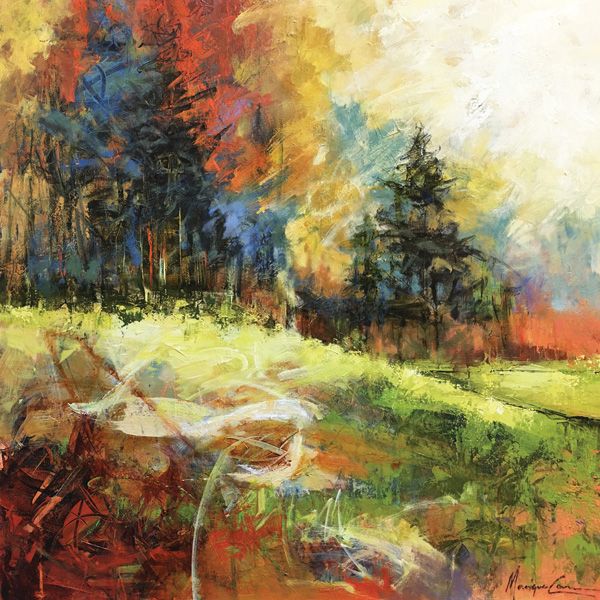
Monique Carr, Nouveau Flamenco, oil, 24 x 24.
For landscape artist Monique Carr, her paintings are always a surprise. After working as a graphic designer and studying under several instructors, Carr returned to her love of fine art and developed a taste for the abstract style that continues to influence her work today. “It allows me this freedom to express many emotions and helps me loosen up my representational work,” she says. “I could not do one style without influences from the other to guide me as I experiment with different aspects of my process.”
Carr paints largely en plein air but says she uses only 20 percent of what she sees, and the rest is interpretation. “My goal is to create a certain mood, transforming what I’m seeing into something more magical by changing the colors,” she says. When Carr begins a painting, the only sure thing is her palette. The artist decides what kinds of colors she wants to work with in advance, before she even knows what she will paint. Her vivid piece NOUVEAU FLAMENCO began as an abstract work until the horizon and its trees began to take shape through the process. Whether she is painting her signature water reflections or colorful meadows, her “abstract aloofness” permeates the scene—just like the exclamation points she hides in each piece to keep the spirit of surprise alive. Carr’s work can be found at Alta Vista Gallery, Valle Crucis, NC; Red Wolf Gallery, Brevard, NC; Lagerquist Art Gallery, Atlanta, GA; York & Friends Fine Art, Nashville, TN; and www.moniquecarr.com.—Mackenzie McCreary
Anne-Marie Kornachuk
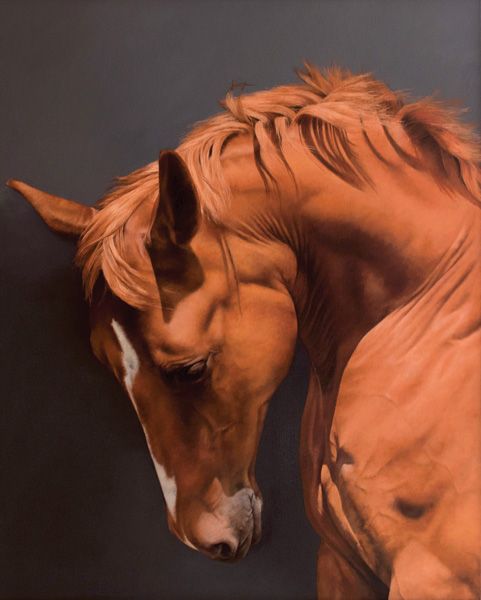
Anne-Marie Kornachuk, If Wishes Were Horses, oil, 50 x 40.
Whether she’s painting figures or horses, Anne-Marie Kornachuk creates images that are hypnotic in their intensity. The artist uses the severe lighting and colorful hues of the Renaissance masters who inspire her, including Diego Velázquez and Caravaggio. For her figures, Kornachuk works with models whom she covers in large dresses or long reams of silk. “I would sculpt the fabric so that it had this animated nature around a still figure with no overt gestures or movements,” she says. “To me that shows an internal life that the viewer can interpret as they wish.”
Recently the artist turned her eye toward the horses she loved as a child. She was struck by their immense scale, especially when life-size images of them are placed into a human-scale space, such as a museum. Soon, she began painting portraits of horses made to scale, personally spending time with each subject. “The way I feel about them is that they imbue drama in their gestures and facial expressions,” Kornachuk says. “They are operatic in the way they move, and I am more comfortable showing this intense emotion with them.” Kornachuk’s work can be found at Trias Gallery, Oakville, Ontario, Canada; Robert Lange Studios, Charleston, SC; Skidmore Contemporary Art, Santa Monica, CA; and www.annemariekornachuk.com. —Mackenzie McCreary
Taisia Kuklina
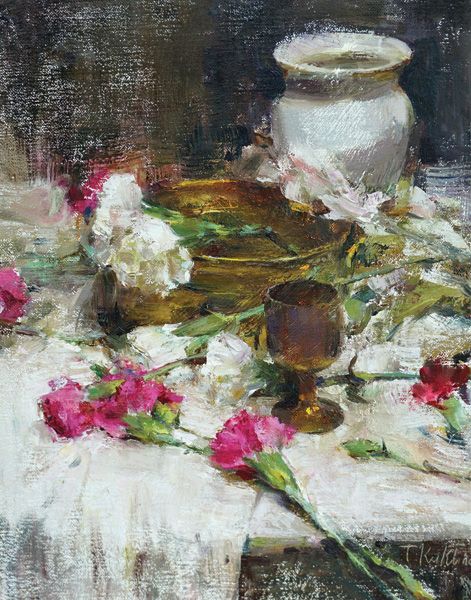
Taisia Kuklina, Still Life With Carnations, oil, 12 x 9.
Taisia Kuklina’s still-life paintings of vessels and flowers seem to evoke her Russian heritage in their soft brushwork and subtle lighting. The Wisconsin-based artist grew up attending art-
preparatory school in central Siberia, with many teachers encouraging her creative intuition. After moving to the United States, Kuklina studied under several painters, including Clayton Beck, Romel de la Torre, and Tony Johnson, during which she developed a taste for still lifes.
Kuklina works entirely alla prima and combines influences from classical Russian painting with modern western realism. “At times I am an impatient person,” she says of working alla prima. “But I also want to maintain the excitement of a first impression as I work.” While she may jump around during her creative process—starting with the brightest color of the piece and then filling in the canvas erratically—Kuklina says the work and subject matter bring her into a meditative mood. Often the artist will return to a painting up to a year later and revitalize it with dry brushing or glazing. “In my paintings I try to find honesty, unity, and cohesiveness,” she says. “It doesn’t always work out, but when it does, it is very satisfying.” Kuklina’s work can be found at www.taisiakuklinafineart.com. —Mackenzie McCreary
Ellen Jean Diederich
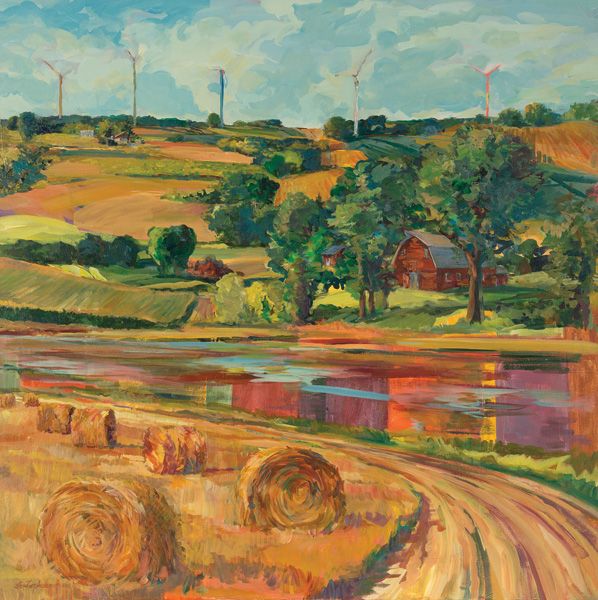
Ellen Jean Diederich, The Great Midwest, acrylic, 40 x 40.
The chores we were tasked with as children generally don’t evoke our warmest memories, but Ellen Jean Diederich fondly recalls working in the fields, milking the cows, and attending to the chickens and sheep on her family’s farm in Staples, MN. “Now I have flower gardens and a few tomatoes,” laughs Diederich. The artist resides in Fargo, ND, these days, and not surprisingly, she gravitates toward agrarian themes in her acrylic and watercolor paintings. Architectural scenes, animals, and her backyard blooms also make regular appearances, and when she is traveling, the sky’s the limit.
Diederich carries a camera just about everywhere she goes, from a local errand run to an excursion in Mexico, always prepared to record a scene with appealing shapes, patterns, shadows, and light. Although she uses these reference photographs when painting, the artist imposes a limit on details. “I like it to look painted,” she says. Plus, overworking a piece can muddy the chromatic vibrancy, she adds. “I’m fascinated with the paint itself, and I want you to see the colors and brushwork.”
Diederich defines her style as neo-impressionism because her paintings are rich in color, texture, and descriptive brushwork. “I don’t like straight lines,” she says. “I use a flat brush, flat like a calligraphy pen, but I want my brush shapes to be unidentifiable.” Above all, Diederich relishes color harmonies. “But I stretch the vocabulary, from dark to light, and it makes my paintings glow,” she says. Find Diederich’s work at Underbrush Gallery, Fargo, ND, and Jean Stephen Galleries, St. Louis Park, MN. —Kim Agricola
Debra Keirce
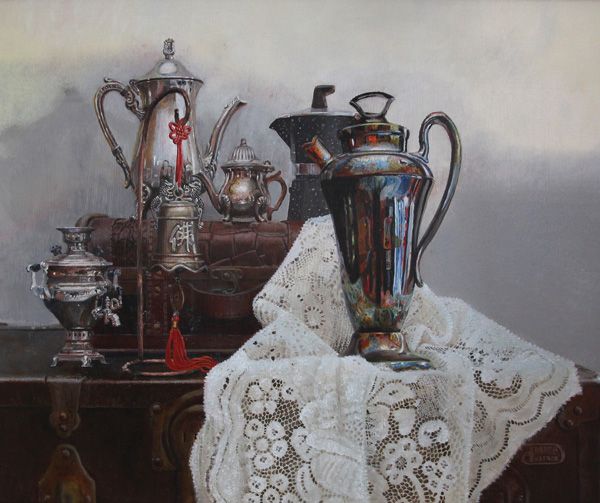
Debra Keirce, Sips, oil, 16 x 20.
“When you’re painting miniatures and working through a magnifying glass, you better be extremely accurate and precise,” Debra Keirce says. “That’s the challenge I love.” Keirce, a still-life artist, didn’t begin painting full time until 2010, after years of working as a chemical engineer in the pharmaceutical industry. Although she had received an art scholarship after high school, she found that her art teachers focused on the conceptual and abstract techniques that were popular at the time, rather than those of the old masters she loved.
Later in life, when she found teachers who fueled her interest, she began painting miniature still lifes (which are smaller than 25 square inches) that combined the precision of her engineering background and her enduring love of fine art. “What I find interesting about it is that it’s the only art where you can really encourage people to take it off the wall and hold it and turn it around,” Keirce says. “It’s a much more intimate experience.” Recently, she has moved on to create more traditionally sized still lifes as well. The artist works in both oil and acrylic, with anywhere between five and 15 pieces in progress at one time. Keirce’s work can be found at Huckleberry Fine Art, Rockville, MD; Seaside Art Gallery, Nags Head, NC; Ellis-Nicholson Gallery, Charleston, SC; and
www.debkart.com. —Mackenzie McCreary
Joey Frisillo
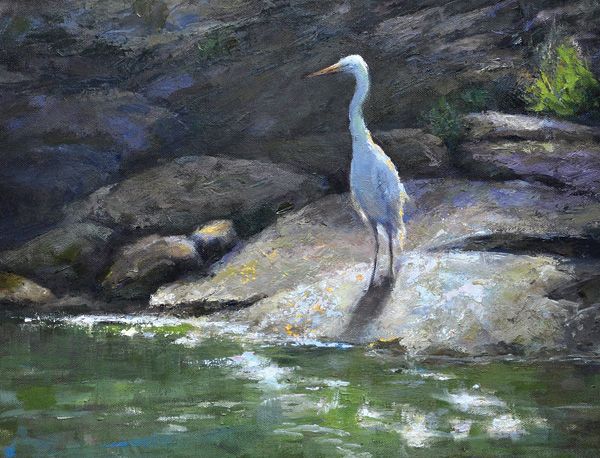
Joey Frisillo, Shadows and Shimmers, oil, 12 x 16.
Joey Frisillo had just started college in Ohio in pursuit of a fine-art degree when life intervened. “That was during the Kent State [shootings], and things got crazy on our campus,” she says. “They shut down our school and sent us home.” So Frisillo headed west and spent 25 years in the oil-and-gas industry. In 1999 she was offered a chance to start over. So she finished a degree in fine art and started painting seriously in 2001. Then in 2003 she became a co-owner of an artists’ gallery. “That launched my career,” Frisillo says. “It was a great opportunity to learn to produce art, meet with clientele, and run a gallery.” Today the artist paints the wild-life and landscape near her Sand Springs, OK, home. “Nature inspires me,” she says. “I have always loved the landscape, even as a little kid. I love reflections and the feeling of water, the translucency of it.” While she works in both oils and pastels, she says, “I have been focusing on the oils recently. I like the textural qualities of the oil paint and the contrast between the thick and thin [brush strokes].” Frisillo’s work is available at Castle Gallery, Fort Wayne, IN; Pierson Gallery, Tulsa, OK; and at www.joeyfrisillo.com. —Laura Rintala
Jennifer Stottle Taylor
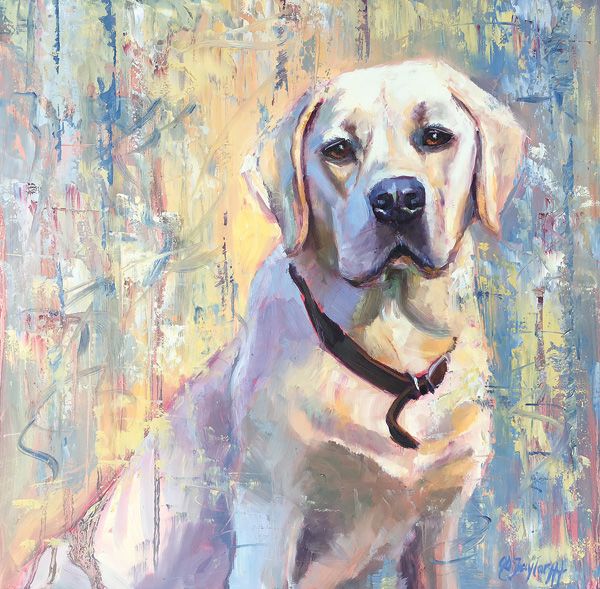
Jennifer Stottle Taylor, Sutton, oil, 16 x 16.
Jennifer Stottle Taylor is endlessly inspired by the life surrounding her. Even when she was little, she began drawing the horses she worked with in competitions. As she continued to learn and fine-tune her skills, she developed an interest in plein-air painting and impressionism. She says studying under renowned painters like Dennis Perrin and Daniel Greene greatly influenced her creative growth. “My main goal is to combine realism with some abstract qualities that come from impressionist techniques,” she says. Taylor is continually trying to loosen up her style by working largely with palette knives to keep from slipping into tight realism. Working wet into wet, the artist may finish a painting in one or two sittings.
While the artist’s oeuvre is largely composed of animal portraits, she began painting interiors and still lifes when she didn’t have access to animal models. Over the past few years her main inspiration has come from tea sets. “My focus is on how the light shining on the porcelain brings out all those different shades of color and light values,” she says. “When you put a heavy light on one side and place colorful things around the object, you can really see those reflections come through, and I love it.” Taylor teaches workshops and is currently seeking gallery representation. She will also be traveling and painting across Europe in the future to broaden her subject matter. Her work can be found at Art & Soul, Huntsville, AL; Pulaski Jewelry Company, Pulaski, TN; and www.jenniferstottletaylor.com. —Mackenzie McCreary
Carrie Nygren
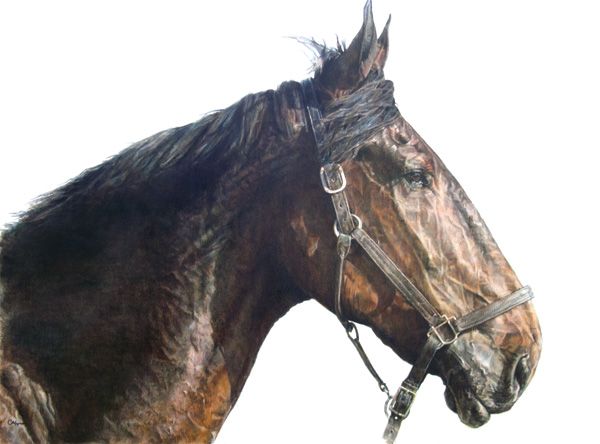
Carrie Nygren, It’s Just the Wind, oil, 30 x 40.
Wisconsin artist Carrie Nygren says, “I never let go of a passion, no matter how long it takes to accomplish it.” That unyielding determination keeps her focused on her oil painting, even at the cost of sleep. Her equestrian and canine works blend traditional techniques and subject matter with fresh, contemporary compositions.
Nygren focuses on horses, she says, “because I know them so well,” and because she can see their individual personalities. “Horses are amazing creatures,” she says. Having grown up around them and having passed on to her daughters a passion for them, Nygren spends weekends at equestrian events taking photos. Then, in her studio, she searches through her images “to find those shots that aren’t just portraiture,” she says. “It’s more of a living moment of the horse and rider,” or a moment that captures the spirit of the animal. “I want to create timeless and enduring paintings that hold up both technically and compositionally—paintings that leave you with that ‘there’s just something about that painting’ feeling that brings you back again and again.” Nygren’s work can be found at www.cnygrenart.com. —Laura Rintala
Tara Moore
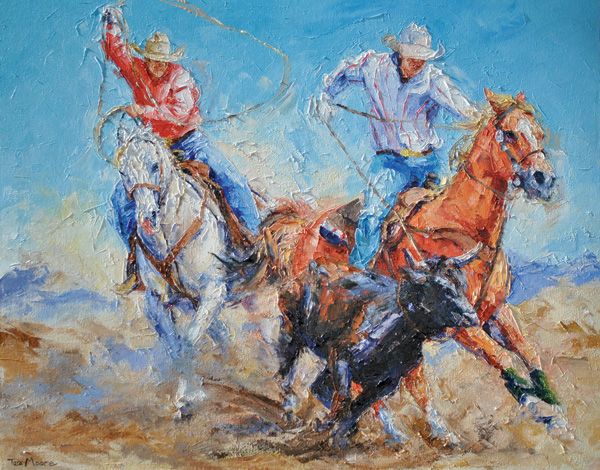
Tara Moore, In the Groove, oil, 24 x 30.
Tara Moore painted portrait commissions and children’s book illustrations for years, but eventually it became a chore. “Somewhere along the line I lost the passion that I began with when I was little,” Moore says. So she packed up everything and moved to Montana, where she let her creative side go wild. The move resulted in a much looser and more expressive style than the strict representational style she had cultivated all those years.
While her main subject matter is still animals—such as the bears that frequent her backyard—she is now incorporating more western scenes inspired by the multiple rodeos she attends each year. Working with oil paints and palette knives, Moore says that her main concern now is depicting the height of action. “The most important thing is to find an exciting scene filled with turmoil,” she says. “I’m always experimenting with that idea because I don’t want to be stuck in the same way that I was before.” But even as she paints the moment a cowboy falls while attempting to rope a calf, she is calm and relaxed in her creative process to avoid the stiffness she has eagerly left behind. Moore’s work can be found at Samarah Fine Art, Whitefish, MT, and West Lives On Gallery, Jackson, WY.
—Mackenzie McCreary
Patricia Rose Ford
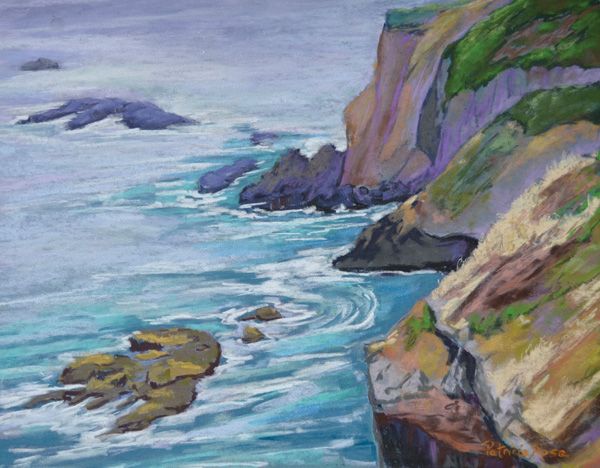
Patricia Rose Ford, Coastal Morning Escape, pastel, 14 x 18.
Patricia Rose Ford strives to make every piece of her work true to the moment when she could deeply feel the world surrounding her easel. Although she always had some type of art influence in her life, it wasn’t until 2003 that she devoted her life to painting after quitting her job as a social worker. Ford began in watercolors while studying in Northern California, where she also fell in love with plein-air painting. “When you are painting that way, you see into the subject much more than if you’re using a reference photo because the camera disguises and suppresses so much,” Ford says. After 10 years of working in watercolors, the artist switched to pastels, her current medium.
Ford finishes every piece on location in the two environments that have become her main inspirations: the ocean and the desert. She finds the jagged cliffs of the California coastline and the towering rock formations of Grand Canyon National Park serve to anchor many of her scenes. The artist frequently visits places like Fort Bragg, CA, and Escalante, UT, as well as areas in New Mexico where renowned painter Georgia O’Keeffe worked for several years. “When you paint outdoors, you’re forced to move along because the light is changing,” Ford says. “I don’t get so bogged down in tiny details, and it forces me to be a bit looser than in my studio.” Ford participates in plein-air events across the country and is a Master Signature Artist with Women Artists of the West. Her work can be found at Purple Sage Gallery, Albuquerque, NM, and www.patriciaroseford.com.
—Mackenzie McCreary
This story was featured in the October 2017 issue of Southwest Art magazine. Get the Southwest Art October 2017 print issue or digital download now–then subscribe to Southwest Art and never miss another story.
MORE RESOURCES FOR ART COLLECTORS & ENTHUSIASTS
• Subscribe to Southwest Art magazine
• Learn how to paint & how to draw with downloads, books, videos & more from North Light Shop
• Sign up for your Southwest Art email newsletter & download a FREE ebook





